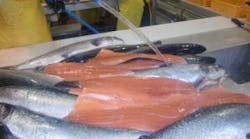Chlorine is the traditional go-to option for sanitation in food plants because of its effectiveness and low cost and despite chlorine’s potential health risks. Handling any powerful oxidizer requires care, however, and that discourages many food processors to explore alternatives such as aqueous ozone and ozone gas.
Ozone is widely used in municipal wastewater treatment, but it was off limits for food processors after the Food Additive Amendment of 1958 failed to include it in a list of approved chemicals. The omission was an oversight, ozone proponents maintain, and extensive research and lobbying was needed before federal regulators allowed its use, first for food-surface sanitation, then in direct contact with food.
Suppliers of ozone generators were euphoric in June 2001 when FDA lifted restrictions on ozone’s use. The decision was a response to a petition led by the Electric Power Research Institute, which liked the idea of a sanitizer that requires consumption of electricity.
But manufacturers are reluctant to change processes that work, and most ozone vendors came and went to pursue more promising avenues, such as swimming pool disinfection. Misapplication also retarded acceptance: Overdosing of water for equipment cleaning generated complaints of pitting of stainless steel, and poultry processors seeking high log reductions on chicken carcasses discovered oxidation could react with lipids and create rancidity issues.
Because the U.S. Department of Commerce oversees seafood processing, ozone’s use in direct contact with fish predates FDA’s approval. Knocking down spoilage organisms and bacteria is essential if fish is to have a realistic shelf life. While U.S. firms have used ozonated water to accomplish that for at least 15 years, their counterparts to the north only recently have had that option. The first Canadian seafood processor to do so was Albion Fisheries Ltd., Richmond, British Columbia.
Ozonated water is applied to fish at Albion Fisheries prior to packaging and frozen distribution.
Albion used a portable ozone generator to create sanitizing water for cleaning equipment and food-contact surfaces in its old processing plant in British Columbia. Managers wanted to include a centralized system for direct contact when they built a 70,000-sq.-ft. facility in Richmond. Health Canada had not considered expanding ozone applications until it received a petition from Ozone International LLC, Albion's Bainbridge Island, Wash., system supplier.
"It took two years and was a long time coming, and it was a bit frustrating for Canadian processors," relates Mark Dennis, the firm's vice president of sales. Worker safety issues and unreliable controls that produced spotty results plagued ozone applications throughout North America in years past, giving ozone a black eye with many food companies. "All they remember is that ozone didn't work," Dennis remarks.
Health Canada gave its blessing in time for the December 2012 opening of Albion's new plant, where ozone-resistant piping delivers treated water to 20 rooms used for processing, receiving, storage and other operations.
"High loads of bacteria will destroy the fish before they go to the freezing plant," notes Musleh Uddin, Albion's director of corporate quality assurance. "There were some worker concerns about off-gassing, but if you explain ozone is eco-friendly and better than chemicals, you can get past those concerns. After nine months of use, the concern is gone."
Ozone is inherently unstable, with the three oxygen elements seeking stability by attaching to carbon, hydrogen and other atoms. Albion’s system generates ozone at a 1.5 ppm ratio; when it reaches the point of use, the concentration is 1.2 ppm, and within 30 seconds it completely dissipates, according to Uddin. Residual amounts become airborne at less than 0.3 ppm, enough to knock out any yeast and mold but not enough to affect human health. “It’s almost like a sterilized plant,” he adds. “Health inspectors have commented that there is no fish smell in the building.”
Albion’s product portfolio includes a line of sushi. “We cannot stop the lipid deterioration with normal freezing, and if fat oxidizes, you get bad odors,” comments Uddin. “Any food intended for raw consumption requires -30 degrees Celsius.” Choosing to err on the side of caution, the firm holds sushi at -70 degrees C/-94 degrees Fahrenheit.
Now that Albion has blazed the ozone trail, many more Canadian processors are likely to follow. They will join a roster of ozone users that includes bottled water companies and most fresh-cut produce suppliers.
Strickland Produce Inc., Nashville, Tenn., was an early champion of ozone. CEO Walter Strickland says the company began rigorous study of ozone in combination with chlorine in 1998. “You get an improved flavor from fruits and vegetables, and it is very beneficial in extending shelf life,” he says.
In a detailed study Strickland conducted and provided to the International Ozone Assn., he calculated a commercial system for washing and packaging fresh-cut salads produced a 21-month payback from a 60 percent reduction in water use and $112,320 in annual labor costs. Additional savings in reduced maintenance and reduced downtime for water changes also accrued.
A skid-mounted ozone metering and monitoring system was included in a hydro-chilling system for refrigerated side dishes manufactured by Kettle Creations in Lima, Ohio, when the facility was built in 2009 (the company was acquired in 2012 by Bob Evans Farms Inc. and is undergoing major expansion). Ozone purifies recirculated water that is sprayed on trays and pouches of mashed potatoes and other dishes as they are conveyed 2,700 ft. through a spiral cooler.
“Chlorine is the old standby” for similar systems," and most food companies opt for chlorine treatment. notes Ken Soper, production manager at Coastline Equipment Inc., the Bellingham, Wash., supplier that fabricated Kettle Creations’ cooler. “But companies that really look at their costs are inclined to choose ozone,” he says.
Don’t fix what’s not broken is a guiding principle in process industries, and even small changes are approached with considerable caution. As the efficacy and cost advantages of ozone become more widely understood, the technology’s role in plant hygiene will grow.


